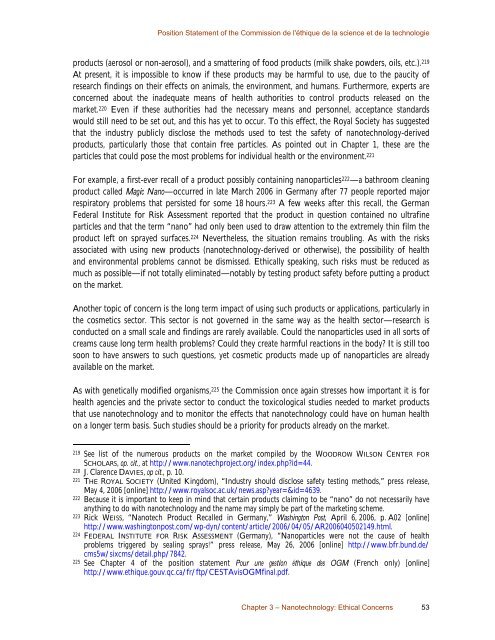A Basis for Action - Commission de l'éthique de la science et de la ...
A Basis for Action - Commission de l'éthique de la science et de la ...
A Basis for Action - Commission de l'éthique de la science et de la ...
You also want an ePaper? Increase the reach of your titles
YUMPU automatically turns print PDFs into web optimized ePapers that Google loves.
Position Statement of the <strong>Commission</strong> <strong>de</strong> l'éthique <strong>de</strong> <strong>la</strong> <strong>science</strong> <strong>et</strong> <strong>de</strong> <strong>la</strong> technologie<br />
products (aerosol or non-aerosol), and a smattering of food products (milk shake pow<strong>de</strong>rs, oils, <strong>et</strong>c.). 219<br />
At present, it is impossible to know if these products may be harmful to use, due to the paucity of<br />
research findings on their effects on animals, the environment, and humans. Furthermore, experts are<br />
concerned about the ina<strong>de</strong>quate means of health authorities to control products released on the<br />
mark<strong>et</strong>. 220 Even if these authorities had the necessary means and personnel, acceptance standards<br />
would still need to be s<strong>et</strong> out, and this has y<strong>et</strong> to occur. To this effect, the Royal Soci<strong>et</strong>y has suggested<br />
that the industry publicly disclose the m<strong>et</strong>hods used to test the saf<strong>et</strong>y of nanotechnology-<strong>de</strong>rived<br />
products, particu<strong>la</strong>rly those that contain free particles. As pointed out in Chapter 1, these are the<br />
particles that could pose the most problems <strong>for</strong> individual health or the environment. 221<br />
For example, a first-ever recall of a product possibly containing nanoparticles 222 —a bathroom cleaning<br />
product called Magic Nano—occurred in <strong>la</strong>te March 2006 in Germany after 77 people reported major<br />
respiratory problems that persisted <strong>for</strong> some 18 hours. 223 A few weeks after this recall, the German<br />
Fe<strong>de</strong>ral Institute <strong>for</strong> Risk Assessment reported that the product in question contained no ultrafine<br />
particles and that the term “nano” had only been used to draw attention to the extremely thin film the<br />
product left on sprayed surfaces. 224 Nevertheless, the situation remains troubling. As with the risks<br />
associated with using new products (nanotechnology-<strong>de</strong>rived or otherwise), the possibility of health<br />
and environmental problems cannot be dismissed. Ethically speaking, such risks must be reduced as<br />
much as possible—if not totally eliminated—notably by testing product saf<strong>et</strong>y be<strong>for</strong>e putting a product<br />
on the mark<strong>et</strong>.<br />
Another topic of concern is the long term impact of using such products or applications, particu<strong>la</strong>rly in<br />
the cosm<strong>et</strong>ics sector. This sector is not governed in the same way as the health sector—research is<br />
conducted on a small scale and findings are rarely avai<strong>la</strong>ble. Could the nanoparticles used in all sorts of<br />
creams cause long term health problems? Could they create harmful reactions in the body? It is still too<br />
soon to have answers to such questions, y<strong>et</strong> cosm<strong>et</strong>ic products ma<strong>de</strong> up of nanoparticles are already<br />
avai<strong>la</strong>ble on the mark<strong>et</strong>.<br />
As with gen<strong>et</strong>ically modified organisms, 225 the <strong>Commission</strong> once again stresses how important it is <strong>for</strong><br />
health agencies and the private sector to conduct the toxicological studies nee<strong>de</strong>d to mark<strong>et</strong> products<br />
that use nanotechnology and to monitor the effects that nanotechnology could have on human health<br />
on a longer term basis. Such studies should be a priority <strong>for</strong> products already on the mark<strong>et</strong>.<br />
219 See list of the numerous products on the mark<strong>et</strong> compiled by the WOODROW WILSON CENTER FOR<br />
SCHOLARS, op. cit., at http://www.nanotechproject.org/in<strong>de</strong>x.php?id=44.<br />
220 J. C<strong>la</strong>rence DAVIES, op cit., p. 10.<br />
221 THE ROYAL SOCIETY (United Kingdom), “Industry should disclose saf<strong>et</strong>y testing m<strong>et</strong>hods,” press release,<br />
May 4, 2006 [online] http://www.royalsoc.ac.uk/news.asp?year=&id=4639.<br />
222 Because it is important to keep in mind that certain products c<strong>la</strong>iming to be “nano” do not necessarily have<br />
anything to do with nanotechnology and the name may simply be part of the mark<strong>et</strong>ing scheme.<br />
223 Rick WEISS, “Nanotech Product Recalled in Germany,” Washington Post, April 6, 2006, p. A02 [online]<br />
http://www.washingtonpost.com/wp-dyn/content/article/2006/04/05/AR2006040502149.html.<br />
224 FEDERAL INSTITUTE FOR RISK ASSESSMENT (Germany), “Nanoparticles were not the cause of health<br />
problems triggered by sealing sprays!” press release, May 26, 2006 [online] http://www.bfr.bund.<strong>de</strong>/<br />
cms5w/sixcms/<strong>de</strong>tail.php/7842.<br />
225 See Chapter 4 of the position statement Pour une gestion éthique <strong>de</strong>s OGM (French only) [online]<br />
http://www.<strong>et</strong>hique.gouv.qc.ca/fr/ftp/CESTAvisOGMfinal.pdf.<br />
Chapter 3 – Nanotechnology: Ethical Concerns 53
















